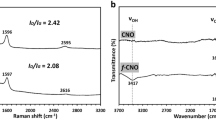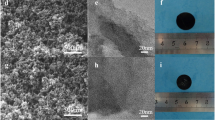Abstract—
The nanocomposite of resorcinol–formaldehyde xerogel (RF-xerogel) and carbon nanotubes after carbonization at 800°С was obtained in the form of composite carbon nanopaper (CCNP) with a thickness of 100–300 microns, a density from 0.1 to 0.5 g/cm2 and an electronic conductivity of more than 10 S/cm. According to the low temperature nitrogen adsorption data, the microporous structure of the nanopaper is formed by carbonized RF-xerogel, and the mesoporous structure is formed by the nanotube framework. The specific surface area of the nanopaper calculated by the method of nonlocal density function theory (NLDFT) exceeds 600 m2/g. The main contribution to the specific surface area of CCNP is made by pores with a width of ~0.7 nm, therefore, electrodes for a supercapacitor made of such paper are quite effective only in aqueous solutions of H2SO4 and KOH with small sizes of solvated ions. A technique for nanopaper activation with potassium hydroxide has been developed for the use of CCNP with organic electrolytes. The maximum specific surface area (NLDFT method) of activated CCNP reaches 1182 m2/g with a loss of carbon xerogel mass of ~25%. At the same time, the pore surface area of more than 1 nm width increases from 350 m2/g in CCNP to 685 m2/g in activated CCNP. Nanopaper has mechanical strength, pretty cheap and convenient for use in supercapacitors.











Similar content being viewed by others
REFERENCES
Pandolfo, A.G. and Hollencamp, A.F., Carbon properties and their role in supercapacitors, J. Power Sources, 2006, vol. 157, p. 11.
Burke, A., Ultracapacitors: why, how, and where is the technology, J. Power Sources, 2000, vol. 91, p. 37.
Burke, A. and Miller, M., The power capability of ultracapacitors and lithium batteries for electric and hybrid vehicle applications, J. Power Sources, 2011, vol. 196, p. 514.
Gogotsy, Y. and Simon, P., True performace metrics in electrical energy storage, Science, 2011, vol. 334, p. 917.
Yang, X., Cheng, Ch., Wang, Y., Qiu, L., and Li, D., Liquid-mediated dense integration of graphene materials for compact capacitive energy storage, Science, 2013, vol. 341, p. 534.
Xu, Y., Lin, Z., Zhong, X., Huang, X., Weiss, N.O., Huang, Y., and Duan, X., Holey graphene frameworks for highly efficient capacitive energy storage, Nat. Commun., 2014, vol. 5, p. 4554.
Zhu, Y., Murali, Sh., Stoller, M.D., Ganesh, K.J., Cai, W., Ferreira, P.J., Pirkle, A., Wallace, R.M., Cychosz, K.A., Thommes, M., Su, D., Stach, E.A., and Ruoff, R.S., Carbon-based supercapacitors produced by activation of graphene, Science, 2011, vol. 332, no. 6037, p. 1537.
Mayer, S.T., Pekala, R.W., and Kaschmitter, J.L., The aerocapacitor: an electrochemical double-layer energy-storage device, J. Electrochem. Soc., 1993, vol. 42, no. 2, p. 446.
Probstle, H., Schmitt, C., and Fricke, J., Button cell supercapacitors with monolithic carbon aerogels, J. Power Sources, 2000, vol. 105, p. 189.
Futaba, D.N., Hata, K., Yamada, T., Hiraoka, T., Hayamizu, Y., Kakudate, Y., Tanaike, O., Hatori, H., Yumura, M., and Iijima, S., Shape-engineerable and highly densely packed single-walled carbon nanotubes and their application as super-capacitor electrodes, Nat. Mater., 2006, vol. 51, p. 987.
Yoon, Y., Lee, K., Kwon, S., Seo, S., Yoo, H., Kim, S., Shin, Y., Park, Y., Kim, D., Choi, J.-Y., and Lee, H., Sheets spatially and densely piled for fast ion diffusion in compact supercapacitors, ACS Nano, 2014, vol. 8, p. 436.
Shi, H., Activated carbons and double layer capacitance, Electrochim. Acta, 1996, vol. 41, no. 10, p. 1633.
Stoller, M.D. and Ruoff, R.S., Best practice methods for determining an electrode materials performance for ultracapacitors, Energy Environ. Sci., 2010, vol. 3, p. 1294.
Bordjiba, M., Mohamedi, L., and Dao, H., Synthesis and electrochemical capacitance of binderless nanocomposite electrodes formed by dispersion of carbon nanotubes and carbon aerogels, J. Power Sources, 2007, vol. 172, p. 991.
An, K.H., Kim, W.S., Park, Y.S., Moon, J.-M., Bae, D.J., Lim, S.Ch., Lee, Y.S., and Lee, Y.H., Electrochemical properties of high-power supercapacitors using single-walled carbon nanotube electrodes, Adv. Funct. Mater., 2001, vol. 11, no. 5, p. 387.
Izadi-Najafabadi, A., Yasuda, S., Kobashi, K., Yamada, T., Futaba, D.N., Hatori, H., Yumura, M., Iijima, S., and Hata, K., Extracting the full potential of single-walled carbon nanotubes as durable supercapacitor electrodes operable at 4 V with high power and energy density, Adv. Mater., 2010, vol. 22, p. 235.
Burke, A. and Miller, M., Testing of electrochemical capacitors: capacitance, resistance, energy density, and power capability, Electrochem. Acta, 2010, vol. 55, p. 7538.
Pekala, R.W., Organic aerogels from the polycondensation of resorcinol with formaldehyde, J. Mater. Sci., 1989, vol. 24, p. 3221.
Saliger, R., Reichenauer, G., and Fricke, J., Evolution of microporosity upon CO2-activation of carbon aerogels, in Studies in Surface Science and Catalysis 128, Unger, K.K. et al., Eds., Elsevier Science B.V., 2000.
Job, N., Pirard, R., Marien, J., and Pirard, J.-P., Porous carbon xerogels with texture tailored by pH control during sol-gel process, Carbon, 2004, vol. 42, p. 619.
Calvo, E.G., Ania, C.O., Zubizarreta, L., Menendez, J.A., and Arenillas, A., Exploring new routes in the synthesis of carbon xerogels for their application in electric double-layer capacitors, Energy Fuels, 2010, vol. 24, p. 3334.
Fang, B. and Binder, L., A modified activated carbon aerogel for high-energy storage in electric double layer capacitors, J. Power Sources, 2006, vol. 163, p. 616.
Schmitt, C., Probstle, H., and Fricke, J., Carbon cloth-reinforced and activated aerogel films for supercapacitors, J. Non-Crystal. Solids, 2001, vol. 285, p. 277.
https://ocsial.com.
Krestinin, A.V., Dremova, N.N., Knerel’man, E.I., Blinova, L.N., Zhigalina, V.G., and Kiselev, N.A., Characterization of SWCNT products manufactured in Russia and the prospects for their industrial application, Nanotech. Russ., 2015, vol. 10, no. 7-8, p. 537.
Vol’fkovich, Yu.M., Rychagov, A.Yu., and Sosenkin, V.E., Effect of the porous structure on the electrochemical characteristics of supercapacitor with nanocomposite electrodes based on carbon nanotubes and resorcinol-formaldehyde xerogel, Russ. J. Electrochem., 2022, vol. 58, no. 9, p. 730. https://doi.org/10.1134/S1023193522090142
Lin, Ch., Ritter, J.A., and Popov, B.N., Correlation of double-layer capacitance with the pore structure of sol-gel derived carbon xerogels, J. Electrochem. Soc., 1999, vol. 146, no. 10, p. 3639.
Barranco, V., Lillo-Rodenas, M.A., Linares-Solano, A., Oya, A., Pico, F., Ibanez, J., Agullo-Rueda, F., Amarilla, J.M., and Rojo, J.M., Amorphous carbon nanofibers and their activated carbon nanofibers as supercapacitor, J. Phys. Chem. C, 2010, vol. 114, p. 10302.
Raymundo-Pinero, E., Azaıs, P., Cacciaguerra, T., Cazorla-Amoros, D., Linares-Solano, A., and Beguin, F., KOH and NaOH activation mechanisms of multiwalled carbon nanotubes with different structural organization, Carbon, 2005, vol. 43, p. 786.
McKee, D.W., Gasification of graphite in carbon dioxide and water vapor-the catalytic effects of alkali metal salts, Carbon, 1982, vol. 20, p. 59.
Lillo-Rodenas, M.A., Cazorla-Amoros, D., and Linares-Solano, A., Understanding chemical reactions between carbons and NaOH and KOH: an insight into the chemical activation mechanism, Carbon, 2003, vol. 41, p. 267.
Thermodynamic Properties of Individual Substances. Handbook, Glushko, V.P., Ed., Moscow: Nauka, 1979, vol. 2, book 2.
Barrett, E.P., Joyner, L.G., and Halenda, P.P., The determination of pore volume and area distributions in porous substances. I. Computations from nitrogen isotherms, J. Am. Chem. Soc., 1951, vol. 73, p. 373. https://doi.org/10.1021/ja01145a126
Brunauer, S., Emmett, P.H., and Teller, E., Adsorption of gases in multimolecular layers, J. Am. Chem. Soc., 1938, vol. 60, p. 309. https://doi.org/10.1021/ja01269a023
Lippens, B.C. and de Boer, J.H., Studies on pore systems in catalysts: the t method, J. Catal., 1965, vol. 4, no. 3, p. 319. https://doi.org/10.1016/0021-9517(65)90307-6
Lufrano, F., Staiti, P., Calvo, E.G., Juarez-Perez, E.J., Menendez, J.A., and Arenillas, A., Carbon xerogels and manganese oxide capacitive materials for advance supercapacitors, J. Electrochem. Sci., 2011, vol. 6, p. 596.
Zubizarreta, L., Arenillas, A., Pirard, J.P., Pis, J.J., and Job, N., Tailoring the textural properties of activated carbon xerogels by chemical activation with KOH, Micropor. Mesopor. Mater., 2008, vol. 115, p. 480.
Everett, D.H. and Powl, J.C., Adsorption in slit-like and cylindrical micropores in the Henry’s law region, J. Chem. Soc., Faraday Trans. I, 1976, vol. 72, p. 619.
Lastoskie, Ch., Gubbins, K.E., and Quirkef, N., Pore size distribution analysis of microporous carbons: a density functional theory approach, J. Phys. Chem., 1993, vol. 97, p. 4786.
Autosorb-1 Operating ManualVer. 1.53.
Lowell, S., Shields, J.E., Thomas, M.A., and Thommes, M., Characterization of Porous Solids and Powders: Surface Area, Pore Size, and Density, Dordrecht: Springer, 2006.
ACKNOWLEDGMENTS
Using the equipment of the Analytical Center for Collective Use of the FRC PCPMC RAS and the Center for Collective Use “New petrochemical processes, polymer composites and adhesives” of the IPHF RAS (no. 77601).
Funding
The work was performed within the framework of the State Task on the topic no. 0089-2019-0012 (State registration no. AAAA19-119032690060-9) and no. 0089-2019-0018 (State registration no. АААА-А19-119022690098-3).
Author information
Authors and Affiliations
Corresponding author
Ethics declarations
The authors state that they have no conflict of interest.
Rights and permissions
About this article
Cite this article
Krestinin, A.V., Knerel’man, E.I., Dremova, N.N. et al. Carbon Nanopaper Produced from Carbon Nanotubes/Resorcinol–Formaldehyde Xerogel Nanocomposite for Electrochemical Supercapasitors. Russ J Electrochem 59, 666–677 (2023). https://doi.org/10.1134/S1023193523090082
Received:
Revised:
Accepted:
Published:
Issue Date:
DOI: https://doi.org/10.1134/S1023193523090082




